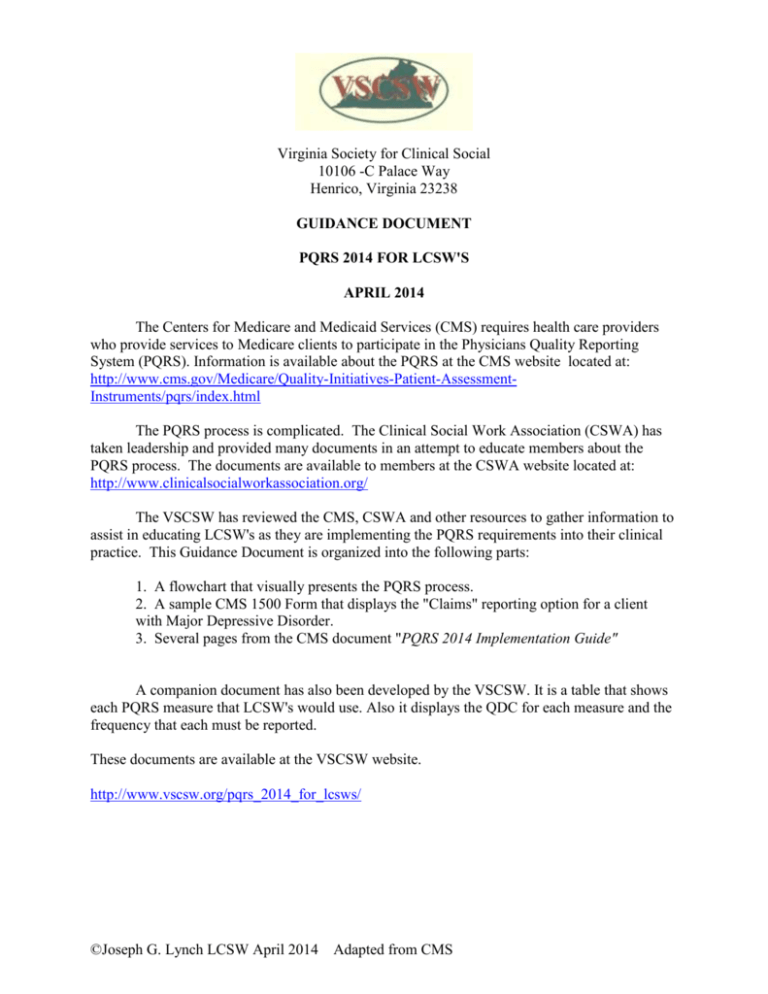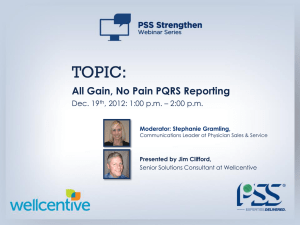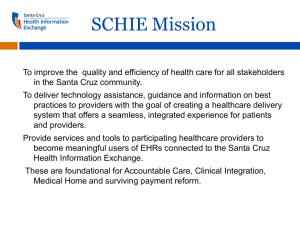
Virginia Society for Clinical Social
10106 -C Palace Way
Henrico, Virginia 23238
GUIDANCE DOCUMENT
PQRS 2014 FOR LCSW'S
APRIL 2014
The Centers for Medicare and Medicaid Services (CMS) requires health care providers
who provide services to Medicare clients to participate in the Physicians Quality Reporting
System (PQRS). Information is available about the PQRS at the CMS website located at:
http://www.cms.gov/Medicare/Quality-Initiatives-Patient-AssessmentInstruments/pqrs/index.html
The PQRS process is complicated. The Clinical Social Work Association (CSWA) has
taken leadership and provided many documents in an attempt to educate members about the
PQRS process. The documents are available to members at the CSWA website located at:
http://www.clinicalsocialworkassociation.org/
The VSCSW has reviewed the CMS, CSWA and other resources to gather information to
assist in educating LCSW's as they are implementing the PQRS requirements into their clinical
practice. This Guidance Document is organized into the following parts:
1. A flowchart that visually presents the PQRS process.
2. A sample CMS 1500 Form that displays the "Claims" reporting option for a client
with Major Depressive Disorder.
3. Several pages from the CMS document "PQRS 2014 Implementation Guide"
A companion document has also been developed by the VSCSW. It is a table that shows
each PQRS measure that LCSW's would use. Also it displays the QDC for each measure and the
frequency that each must be reported.
These documents are available at the VSCSW website.
http://www.vscsw.org/pqrs_2014_for_lcsws/
©Joseph G. Lynch LCSW April 2014
Adapted from CMS
PREREQUISITS
1. You must have a National Provider Identifier # (NPI)
2. You must be or become a Medicare provider through
the Internet-based Provider Enrollment, Chain and
Ownership System (PECOS).
CMS
CMS means the Center for
Medicare and Medicade Services
PQRS - PHYSICIAN QUALITY REPORTING SYSTEM
PQRS REPORTING OPTIONS
There are two ways for LCSWs to report PQRS data in 2014:
1) To submit measures on CMS-1500 claims, or 2) Join a registry which will process PQRS data for you.
The claims option for reporting is highly recommended for LCSW's
MEASUERS FOR LSCW'S TO USE
#106 Adult Major Depressive Disorder (MDD): Comprehensive Depression Evaluation: Diagnosis and Severity
#107 Adult Major Depressive Disorder (MDD): Suicide Risk Assessment
#128 Adult Major Depressive Disorder (MDD): Suicide Risk Assessment
#130 Documentation of Current Medications in the Medical Record
#134 Preventive Care and Screening: Screening for Clinical Depression and Follow-Up Plan
#173 Preventive Care and Screening: Unhealthy Alcohol Use – Screening
#181 Elder Maltreatment Screen and Follow-Up Plan
#226 Preventive Care and Screening: Tobacco Use: Screening and Cessation Intervention:
#247 Substance Use Disorders: Counseling Regarding Psychosocial and Pharmacologic Treatment Options for
Alcohol Dependence
#248 Substance Use Disorders: Screening for Depression Among Patients with Substance Abuse or Dependence
REPORT ALL MEASUERS THAT APPLLY TO YOUR MEDICARE CLIENTS
THE MEASURES MUST BE REPORTED FOR AT LEAST 50% OF THE MEDICARE CLIENTS YOU SEE
Claims-based Measure-Applicability Validation (MAV)
If less than 9 measures apply to the Eligible professional (EP), then the EP must report 1-8 measures for which
there is Medicare patient data. The EP would also be subject to Claims-based Measure-Applicability Validation
(MAV). For those EPs who satisfactorily submit quality-data codes (QDCs) for fewer than 9 PQRS measures across
3 domains, a Claims-Based MAV process will determine whether they should have submitted additional measures or
domains. For payment adjustment considerations for those EPs who satisfactorily submit QDCs for fewer than 3
PQRS measures, the MAV process will determine whether an EP should have submitted for additional measures.
Measures with a 0% performance rate will not be counted.
DOMAINS
THE MEASURES YOU SELECT MUST MATCH AT LEAST THREE OF THE BELOW DOMAINS
1. Patient Safety
2. Person and Caregiver-Centered
Experience and Outcomes
3. Communication and Care Coordination
4. Effective Clinical Care
5. Community/Population Health
6. Efficiency and Cost Reduction
EVEN THOUGH YOU ARE REQUIRED TO MATCH AT LEAST THREE DOMAINS YOU ARE NOT REQUIRED TO
REPORT THE DOMAINS - MEDICARE WILL USE THE DATA YOU DO REPORT TO DETERMINE IF YOU
MATCHED THREE DOMAINS
©Joseph G. Lynch LCSW April 2014
Adapted from CMS
Pointer = Match the letter from line 21
with the diagnosis for this CPT Code and
Date of service.
DSM
Diagnosis
296.32
code
Date of
Service
4
CPT
CODE
4
6
6
14
14
4
6
4
6
14
14
11
90834
A
1040F
A
00
125
0
1
01
***************
*******************
You must
enter a not
collected
charge of
0,00 or 0,01
QDC is
entered
here
For instructions
on use of
modifiers see
"Use of CPT II
Modifiers" in
the next section
For detailed instructions on filling out the CMS 1500 form see hyperlink below:
http://www.cms.gov/Regulations-andGuidance/Guidance/Manuals/downloads/clm104c26.pdf
The next five pages come from the Centers for Medicare & Medicaid Services and give
detailed instructions on reporting via claims
2014 Physician Quality Reporting System (PQRS): Implementation Guide
02/27/2014
©Joseph G. Lynch LCSW April 2014
Adapted from CMS
Reporting via Claims
The 2014 Physician Quality Reporting System (PQRS) Measure Specifications Manual for Claims and
Registry Reporting of Individual Measures can be found at http://www.cms.gov/Medicare/Quality-InitiativesPatient-Assessment-Instruments/PQRS/MeasuresCodes.html.
Identify Eligible Cases
Ensure that the practice identifies and reports on all eligible cases for the measures selected by the practice.
Consider implementing an edit on the billing software that will flag each claim every time a combination of codes
listed in a measure’s denominator is billed so the entry of quality-data codes (QDCs) is required prior to final
submission. Additional PQRS educational resources are available as downloads at
http://www.cms.gov/Medicare/Quality-Initiatives-Patient-Assessment-Instruments/PQRS.
Claims Reporting Criteria
EPs may earn a 2014 PQRS incentive by meeting one of the following criteria for satisfactory reporting:
• Report on at least 9 measures covering 3 National Quality Strategy (NQS) domains for at least 50% of
the EP’s Medicare Part B FFS patients. o EPs that submit quality data for
http://www.cms.gov/Medicare/Quality-Initiatives-Patient-AssessmentInstruments/PQRS/AnalysisAndPayment.html) only 1 to 8 PQRS for at least 50% of their patients
or encounters eligible for each measure, OR that submit data for 9 or more PQRS measures
across less than 3 domains for at least 50% of their patients or encounters eligible for each
measure will be subject to Measure-Applicability Validation (MAV).(See
Note: Measures with a 0% performance rate will not be counted.
To avoid the 2016 payment adjustment, EPs must meet one of the following criteria:
• Satisfactorily report and earn the 2014 PQRS incentive.
• Report at least 3 measures covering 1 NQS domain for at least 50% of the EP’s Medicare Part B FFS
patients satisfactorily. o EPs who satisfactorily submit valid QDCs for only 1 or 2 PQRS measures
for at least 50% of their patients or encounters eligible for each measure will be subject to the MAV
process to determine whether an EP should have submitted additional measures.
Claims-based reporting: Quality data reported to CMS through Medicare Part B claims (containing valid QDC line
items for each individual professional’s NPI) are processed to final action by the Carrier or A/B MAC and
subsequently transferred to the NCH where it is available for PQRS analysis. See Appendix E. Quality measures
data reported on claims denied for payment are not included in PQRS analysis. QDC line items from claims are
analyzed according to the measure specifications, including coding instructions, reporting frequency, and
performance timeframes. See Appendix I for a flow diagram of the PQRS claims-based process.
Use of Current Procedural Terminology (CPT) Category I Modifiers
PQRS measure specifications include specific instructions regarding inclusion of the CPT Category I modifiers.
Unless otherwise specified, CPT Category I codes may be reported with or without CPT modifiers. Refer to each
individual measure specification for detailed instructions regarding CPT Category I modifiers that qualify or do not
qualify a claim for denominator inclusion.
Note that surgical procedures billed by an assistant surgeon(s) will be excluded from the denominator population so
his/her performance rates will not be negatively impacted for PQRS. Analysis will exclude otherwise PQRS-eligible
CPT Category I codes, when submitted with assistant surgeon modifiers 80, 81, 82, or AS. The primary surgeon, not
the assistant surgeon, is responsible for performing and reporting the quality action(s) in applicable PQRS measures.
©Joseph G. Lynch LCSW April 2014
Adapted from CMS
Eligible CPT Category I procedure codes, billed by surgeons performing surgery on the same patient,
submitted with modifier 62 (indicating two surgeons, i.e., dual procedures) will be included in the
denominator population for
Version 8. CPT only copyright 2013 American Medical Association. All rights reserved.
Page 14 of 43 2 02/27/2014
applicable PQRS measure(s). Both surgeons taking part in PQRS will be fully accountable for the clinical action(s)
described in the PQRS measure(s).
Quality-Data Codes
QDCs are non-payable Healthcare Common Procedure Coding System (HCPCS) codes comprised of specified CPT
Category II codes and/or G-codes that describe the clinical action required by a measure’s numerator. Clinical
actions can apply to more than one condition and, therefore, can also apply to more than one measure. Where
necessary, to avoid shared CPT Category II codes, G-codes are used to distinguish clinical actions across measures.
Some measures require more than one clinical action and, therefore, have more than one CPT Category II code, Gcode, or a combination associated with them. EPs should review numerator reporting instructions for each measure
carefully.
CPT Category II Codes
CPT Category II or CPT II codes, developed through the CPT Editorial Panel for use in performance measurement,
serve to encode the clinical action(s) described in a measure’s numerator. CPT II codes consist of five alphanumeric
characters in a string ending with the letter “F.” CPT II codes are not modified or updated during the reporting period
and remain valid for the entire program year as published in the measure specifications manuals and related
documents for PQRS.
Use of CPT II Modifiers
CPT II modifiers are unique to CPT II codes and may be used to report measures by appending the appropriate
modifier to a CPT II code as specified for a given measure. The modifiers for a code cannot be combined and their
use is guided by the measure’s coding instructions, which are included in the numerator coding section of the
measure specifications. Use of the modifiers is unique to CPT II codes and may not be used with other types of CPT
codes. Only CPT II modifiers may be appended to CPT II codes. Descriptions of each modifier are provided below to
help identify circumstances when the use of a modifier may be appropriate. Note that reporting an exclusion or
reporting modifier will alter an EP’s performance rate. Accurate reporting on all selected measures will count toward
incentive, whether the clinical action is reported as complete or not complete (or performance met or not met).
CPT II code modifiers fall into two categories; exclusion modifiers and the 8P reporting modifier.
Exclusion modifiers may be appended to a CPT II code to indicate that an action specified in the measure was not
provided due to medical, patient, or system reason(s) documented in the medical record. These modifiers serve as
denominator exclusions for the purpose of measuring performance. Not all exclusions will apply to every measure,
and some measures do not allow any performance exclusions. Reasons for appending a performance measure
exclusion modifier fall into one of three categories:
• 1P Performance measure exclusion modifier due to medical reasons includes:
o Not indicated (absence of organ/limb, already received/performed, other)
o Contraindicated (patient allergy history, potential adverse drug interaction, other)
o Other medical reasons
• 2P Performance measure exclusion modifier due to patient reasons includes:
o Patient declined
o Economic, social, or religious reasons
o Other patient reasons
• 3P Performance measure exclusion modifier due to system reasons includes:
o Resources to perform the services not available (e.g., equipment, supplies)
o Insurance coverage or payer-related limitations
o Other reasons attributable to health care delivery system
©Joseph G. Lynch LCSW April 2014
Adapted from CMS
The 8P reporting modifier is available for use only with CPT II codes to facilitate reporting an eligible
case when an action described in a measure is not performed and the reason is not specified.
Version 8.2 CPT only copyright 2013
American Medical
Association.
All rights reserved.
Page
15 of 43in
02/27/2014
Instructions
for appending
this reporting
modifier to CPT Category II codes are
included
applicable measures. Use of the 8P reporting
modifier indicates that the patient is eligible for the measure; however, there is no indication in the record that the
action described in the measure was performed, nor was there any documented reason attributable to the
exclusion modifiers.
• 8P Performance measure reporting modifier - action not performed, reason not otherwise specified
The 8P reporting modifier facilitates reporting an eligible case on a given measure when the clinical action does
not apply to a specific encounter. Eligible professionals can use the 8P modifier to receive credit for satisfactory
reporting but will not receive credit for performance. Eligible professionals should use the 8P reporting modifier
sensibly for applicable measures they have selected to report. The 8P modifier may not be used freely in an
attempt to meet satisfactory reporting criteria without regard toward meeting the practice’s quality improvement
goals.
Note: Measures with a 0% performance rate and measures groups containing a measure with a 0%
performance rate will not be counted.
For example, an EP has selected and submitted QDCs during the reporting period for 2014 PQRS Measure #6,
Coronary Artery Disease (CAD): Antiplatelet Therapy. The EP sees a patient for whom he does not choose to
prescribe oral antiplatelet therapy and the reason is not specified. However, the claim(s) for services for that
encounter contains International Classification of Diseases, Ninth Revision, Clinical Modification (ICD-9-CM),
and CPT codes that will draw the patient into the measures’ denominator during analysis. The 8P modifier
serves to include the patient in the numerator when reporting rates are calculated for PQRS.
Claims-Based Reporting Principles
Up to four diagnoses can be reported in the header on the current CMS-1500 paper claim and up to eight diagnoses
can be reported in the header on the electronic claim. Beginning 4/1/2014, up to 12 diagnosis may be reported in the
electronic claim.
o Only one diagnosis can be linked to each line item, although for PQRS all diagnosis codes will be taken into
consideration for analysis.
o PQRS analyzes claims data using ALL diagnoses from the base claim (Item 21 of the CMS-1500 or
electronic equivalent) and service codes for each individual eligible professional (identified by individual
NPI).
o Eligible professionals should review ALL diagnosis and encounter codes listed on the claim to make
sure they are capturing ALL chosen measures applicable to that patient’s care.
All diagnoses reported on the base claim will be included in PQRS analysis, as some measures require reporting
more than one diagnosis on a claim.
o For line items containing a QDC, only one diagnosis from the base claim should be referenced in the
diagnosis pointer field.
o To report a QDC for a measure that requires reporting of multiple diagnoses, enter the reference number in
the diagnosis pointer field that corresponds to one of the measure’s diagnoses listed on the base claim.
Regardless of the reference number in the diagnosis pointer field, all diagnoses on the claim(s) are
considered in PQRS analysis.
If billing software limits the number of line items available on a claim, you should add a nominal amount such as a
penny to one of the line items on that second claim for a total charge of one penny.
o PQRS analysis will subsequently join claims based on the same beneficiary for the same date-of-service, for
the same Taxpayer Identification Number/National Provider Identifier (TIN/NPI) and analyze as one claim.
o Providers should work with their billing software vendor/clearinghouse regarding line limitations for claims to
ensure that diagnoses, QDCs, or nominal charge amounts are not dropped.
©Joseph G. Lynch LCSW April 2014
Adapted from CMS
A sample CMS-1500 form can be found in Appendix E of this document.
Principles for Reporting QDCs via Claims
The following principles apply for claims-based reporting of PQRS measures:
QDCs 2013
must American
be reported:
Version 8. CPT only 1.
copyright
Medical Association. All rights reserved.
Page 16 of 43
2 02/27/2014
• On the claim(s) with the denominator billing code(s) that represents the eligible Medicare Part B PFS
encounter
• For the same beneficiary
• For the same date of service (DOS)
• By the same eligible professional (individual rendering NPI) that performed the covered service,
applying the appropriate encounter codes (ICD-9-CM, CPT Category I or HCPCS codes). These
codes are used to identify the measure's denominator.
2. QDCs must be submitted with a line-item charge of one penny ($0.01) at the time the associated covered
service is performed.
• The submitted charge field cannot be blank
• The line item charge should be $0.01 – the beneficiary is not liable for this nominal amount
• Entire claims with a $0.01 charge will be rejected
• When the $0.01 nominal amount is submitted to the Carrier or A/B Medicare Administrative Contractor
(MAC), the PQRS code line will be denied but will be tracked in the National Claims History (NCH)
for analysis
• Important: In an effort to streamline reporting of QDCs across multiple CMS quality reporting
programs, CMS strongly encourages all EPs and practices to begin billing 2014 QDCs with a
$0.01 charge. EPs should pursue updating their billing software to accept the $0.01 charge
prior to implementing 2014 PQRS. EPs and practices will need to work with their billing software
or EHR vendor to ensure this capability is activated. Entering the nominal charge of $0.01 on
claims will help ensure the QDCs are processed into the CMS claims database.
3. When a group bills, the group NPI is submitted at the claim level; therefore, the individual
rendering/performing physician’s NPI must be placed on each line item, including all allowed charges
and quality-data line items. Solo practitioners should follow their normal billing practice of placing their
individual NPI in the billing provider field (#33a on the CMS-1500 form or the electronic equivalent).
Note: Claims may NOT be resubmitted for the sole purpose of adding or correcting QDCs. If a denied claim is
subsequently corrected through the appeals process to the Carrier or A/B MAC, with accurate codes that also
correspond to the measure’s denominator, then QDCs that correspond to the numerator should also be included on
the resubmitted claim as instructed in the measure specifications.
Remittance Advice (RA) / Explanation of Benefits (EOB)
The RA/EOB denial code N365 is your indication that the PQRS codes are valid for the 2014 PQRS reporting year.
• The N365 denial code is just an indicator that the QDC codes are valid for 2014 PQRS. It does
not guarantee the QDC was correct or that reporting thresholds were met. However, when a
QDC is reported satisfactorily (by the individual EP), the N365 can indicate that the claim will
be used in calculating incentive eligibility. o Important: In an effort to streamline reporting
of QDCs across multiple CMS quality reporting programs, CMS strongly encourages all
EPs and practices to begin billing 2014 QDCs with a $0.01 charge. EPs should pursue
updating their billing software to accept the $0.01 charge prior to implementing 2014
PQRS. EPs and practices will need to work with their billing software or EHR vendor to
ensure this capability is activated.
o Please Note: Effective on 4/1/2014, EPs who bill on a $0.00 QDC line item will receive the
N620 code. It replaces the current N365, which will be deactivated effective 7/1/2014. EPs
who bill on a $0.01 QDC line item will receive the CO 246 N572 code.
©Joseph G. Lynch LCSW April 2014
Adapted from CMS
o All submitted QDCs on fully processed claims are forwarded to the CMS warehouse for analysis
by the CMS quality reporting program, so providers will first want to be sure they do see the
QDC’s line item on the RA/EOB, regardless of whether the new RA (N620) code appears.
Version 8.2 CPT only copyright 2013 American Medical Association. All rights reserved.
Page 17 of 43
02/27/2014
Keep track of all cases reported so that you can verify QDCs reported against the remittance advice
notice sent by the Carrier or A/B MAC. Each QDC line-item will be listed with the N365 denial remark
code.
Remittance Advice Remark Code (RARC) for QDCs with $0.00
The new RARC code N620 is your indication that the PQRS codes were received into the CMS National Claims
History (NCH) database.
• EPs who bill with $0.00 charge on a QDC line item will see N620 instead of N365.
• EPs will receive code N620 on the claim EOB form beginning 4/1/2014.
• N620 reads: This procedure code is for quality reporting/informational purposes only.
• EPs who bill with a $0.00 charge on a QDC line item will receive an N620 code on the EOB and may or may
not receive any Group Code or CARC.
Claim Adjustment Reason Code (CARC) for QDCs with $0.01
The new CARC 246 with Group Code CO or PR and with RARC N572 indicates that this procedure is not payable
unless non-payable reporting codes and appropriate modifiers are submitted.
• In addition to N572, the remittance advice will show Claim Adjustment Reason Code (CARC) CO or PR 246
(This non-payable code is for required reporting only).
• CARC 246 reads: This non-payable code is for required reporting only.
• EPs who bill with a charge of $0.01 on a QDC item will receive CO 246 N572 on the EOB.
Submission through Carriers or A/B MACs
QDCs shall be submitted to Carriers or A/B MACs either through:
• Electronic-based Submission:
PQRS QDCs are submitted on the claim just like any other code; however, QDCs will have a $0.00 (or
nominal) charge. Electronic submission, which is accomplished using the ASC X 12N Health Care Claim
Transaction (Version 5010), should follow the current HIPAA standard version of the ASC x12 technical
report 3.
OR
• Paper-based Submission
Paper-based submissions are accomplished using the CMS-1500 claim form as described in the sample
claims provided in Appendix E.
Group NPI Submission
When a group bills, the group’s NPI is submitted at the claim level, therefore, the individual rendering EP’s NPI must
be placed on each line item, including all allowed charges and quality-data line items.
Solo NPI Submission
The individual NPI of the solo practitioner must be included on the claim as is the normal billing process for
submitting Medicare claims. For PQRS, the QDC must be included on the claim(s) representing the eligible
encounter that is submitted for payment at the time the claim is initially submitted in order to be included in PQRS
analysis.
CMS-1500 Claim Example
There are two examples of a claim in CMS-1500 format that illustrates how to report several PQRS measures is
provided. See Appendix E for the current CMS-1500 claim form (version 08/05) effective through 03/31/2014 and
the new updated CMS-1500 claim form (version 02/12) beginning 04/01/2014.
©Joseph G. Lynch LCSW April 2014
Adapted from CMS
Timeliness of Quality Data Submission
Claims processed by the Carrier or A/B MAC must reach the national Medicare claims system data warehouse
(National Claims History file) by February 27, 2015 to be included in the analysis. Claims for services furnished
toward the end of the reporting period should be filed promptly. Claims that are resubmitted only to add QDCs will not
be included in the analysis.
Version 8.2 CPT only copyright 2013 American Medical Association. All rights reserved.
©Joseph G. Lynch LCSW April 2014
Adapted from CMS
Page 18 of 43
02/27/2014




